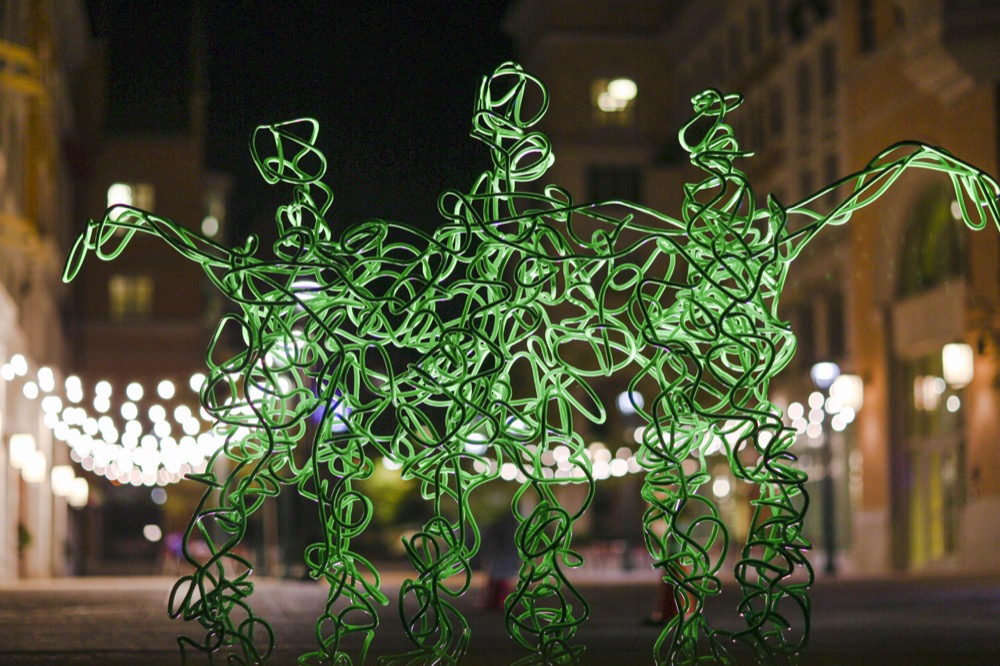News
New sculpture elicits mixed reactions from returning students
Students who have long met at the Bunny or the Clocktower now have a third option around which to congregate: Swamp Creature Friends.
The sculpture, conceptualized and created by Washington University alumnus Tom Friedman and commissioned through the Art on Campus program, made its debut on the South 40 this fall.

A new sculpture, entitled “Swamp Creature Friends” now calls the South 40 home. Students have voiced mixed reactions regarding the sculpture, which was created by Wash. U. alumnus Tom Friedman.
Through the first week of classes, the sculpture has received mixed reviews from both incoming freshmen and returning upperclassmen.
Some students noted that the color of the piece felt a bit out of place amongst the more traditional architecture of the South 40.
“It feels too bright,” sophomore Claire Quinlan said. “I feel like all the other architecture is so well thought about, it fits. When they build new things, it all fits; the style is so classic. The new sculpture just doesn’t feel classic to me at all.”
“I think the green is a little bright. If you look at Wash. U. green, it’s a little bit of a darker hue. But I think it looks nice at night when it’s lit up,” sophomore Cassie Bergman added.
Other students disagreed, finding the contrasting colors and less traditional form as the sculpture’s more appealing aspects.
“I think it adds some interest to campus because it’s not something that blends in well with the scenery here,” freshman Bersabeh Zenebe said.
“I’m not used to it right now, but it looks pretty nice,” sophomore Victor Gutierrez added. “It looks inviting. It looks like three people who are happy and having a good time.”
Bergman also noted that because the artist is an alumnus of Washington University, the sculpture could be considered a direct product of the Sam Fox School.
Swamp Friends isn’t the only new piece to result from the Art on Campus program. The University also commissioned a large piece to be painted on the interior of the new Sumers Athletic Complex by internationally-acclaimed artist Katharina Grosse.
The Art on Campus program, which was first proposed about a decade ago, seeks to bring art of any medium to campus alongside the many capital, or construction, projects. Carmon Colangelo, the dean of the Sam Fox School, was one of the original architects of the program. He met with students and other deans to determine how to best invigorate the campus when he arrived.
“A number of people had mentioned to me that we have a great museum, we have a great campus, but it seemed to be lacking in diversity. It seemed to be lacking in ways to express the innovative culture of Washington University,” Colangelo said.
Seeing that other peer institutions such as Harvard University and the Massachusetts Institute of Technology had “percent for art programs,” Colangelo presented an idea that 1 percent of the budget, with a cap of $500,000, of all the capital projects occurring on campus would be dedicated to an art commission. The policy was approved in 2010.
While most students were receptive to the aims of the initiative, some wished it would bring more controversial works to campus. Junior Finnegan Roy-Nyline, a student in the Sam Fox School, noted that the University tends to bring unobjectionable works to campus.
“I do think the University could take more risks with it, and I think that would be more exciting for everybody and it would end up benefiting maybe the University a lot more,” Roy-Nyline said.
He also advocated for more student input in the commission and for student artwork to be considered as permanent installments on campus.
“On campus, you see a lot of big names in art-making and that’s fine, but I think a lot of other schools that do put their resources into the students kind of reap the benefits,” Roy-Nyline said.
For his part, Colangelo felt the art added an important facet to campus, whether or not the pieces were universally well-received by the students.
“They animate the campus in some way; they add different voices, bring a kind of expression to the campus that gives it—like the Barry Flanagan bunny, some people love it, some people may not—but it becomes part of the culture of the campus,” Colangelo said.
